Can Chiropractors Bill Physical Therapy? Complete Billing Guide 2025

Can Chiropractors Bill Physical Therapy? Complete Billing Guide 2025

Can chiropractors bill for physical therapy services? This fundamental question affects thousands of healthcare practitioners across the United States. The intersection between chiropractic care and physical therapy billing creates complex regulatory challenges that require careful navigation to ensure compliance and maximize legitimate reimbursement opportunities.
Many clinic owners often ask can chiropractors bill physical therapy? In this guide, we’ll break down CPT codes, state regulations, and billing strategies to help you stay compliant and maximize reimbursements.
Understanding the boundaries between chiropractic manipulation codes and physical therapy CPT codes is essential for practice success, regulatory compliance, and optimal patient care delivery.
Understanding Chiropractic Authority for Physical Therapy CPT Code Billing
Legal Framework for Chiropractor Physical Therapy Service Billing
The authority for chiropractors to bill physical therapy CPT codes depends on multiple regulatory factors that vary significantly by state jurisdiction. While chiropractors receive extensive training in musculoskeletal conditions, their billing privileges for PT services are governed by specific limitations.
Primary Regulatory Factors:
- State chiropractic licensing board regulations
- Individual insurance payer policy requirements
- Professional scope of practice limitations
- Continuing education and certification mandates
- Equipment and facility compliance standards
State Licensing Authority Variations: Different states maintain varying approaches to chiropractic scope of practice, creating a complex regulatory landscape for practitioners seeking to understand their billing authority for physical therapy related services.
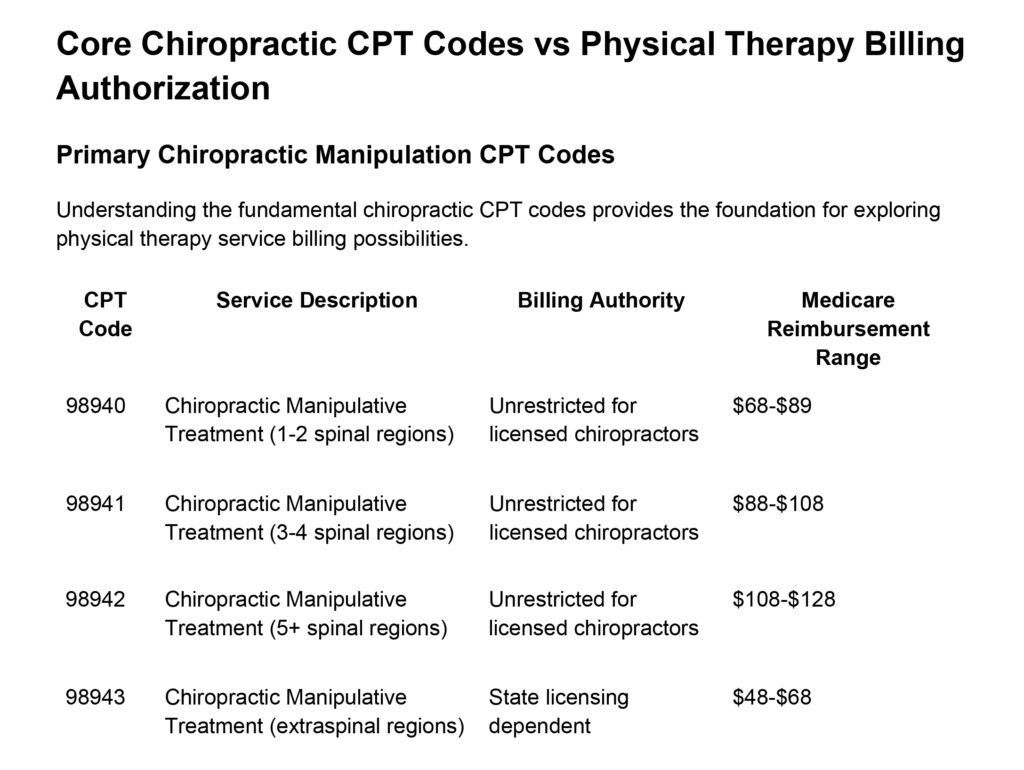
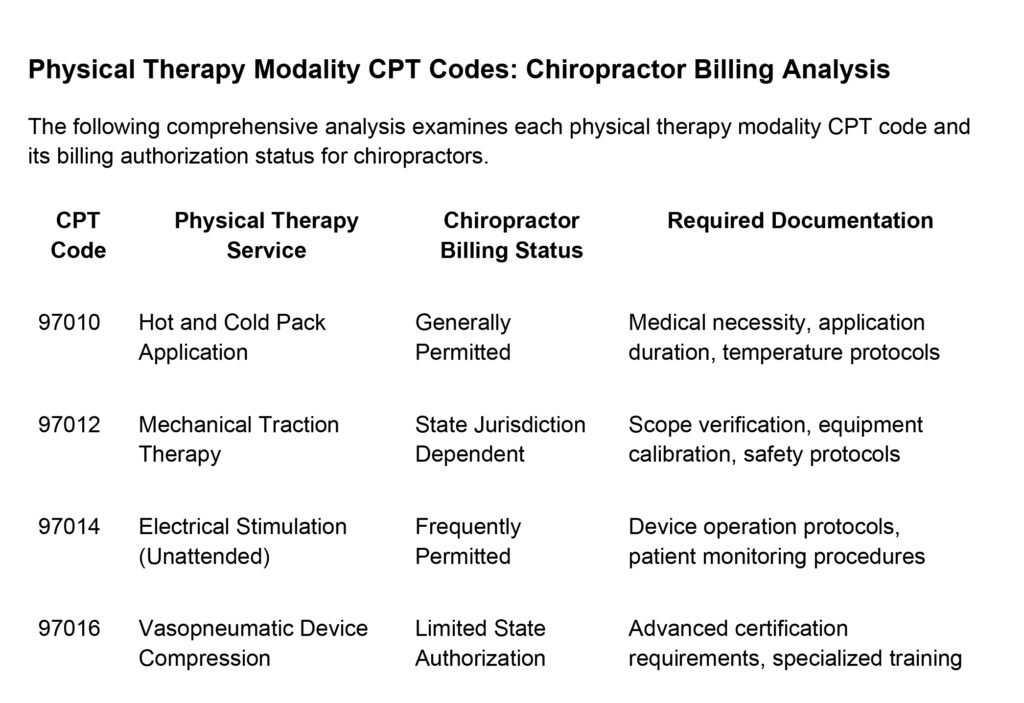
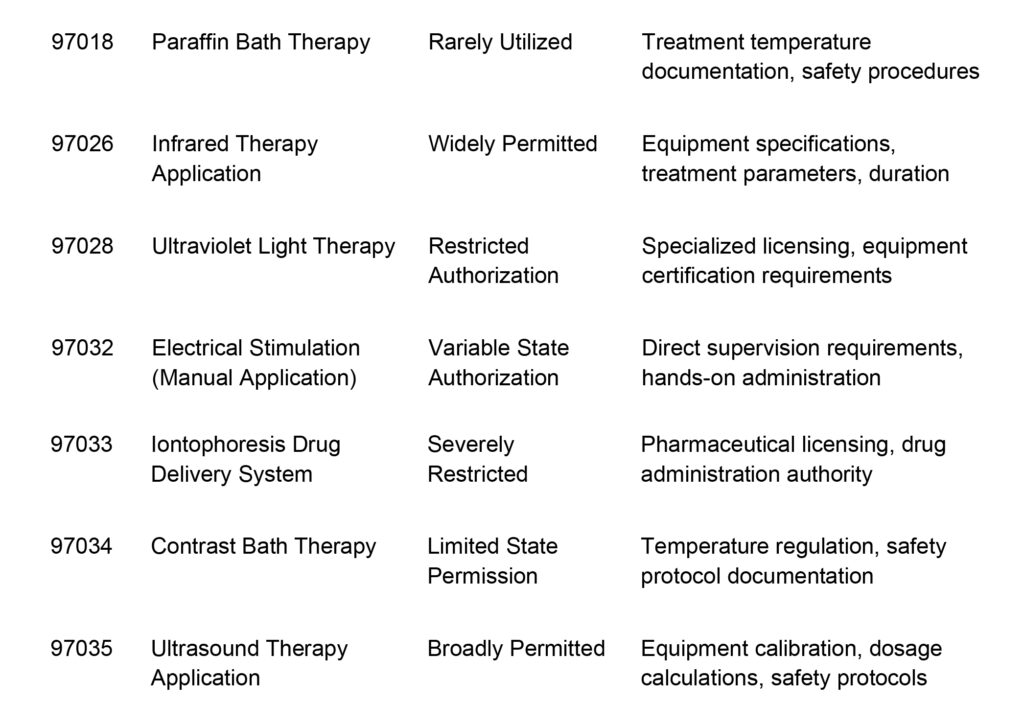
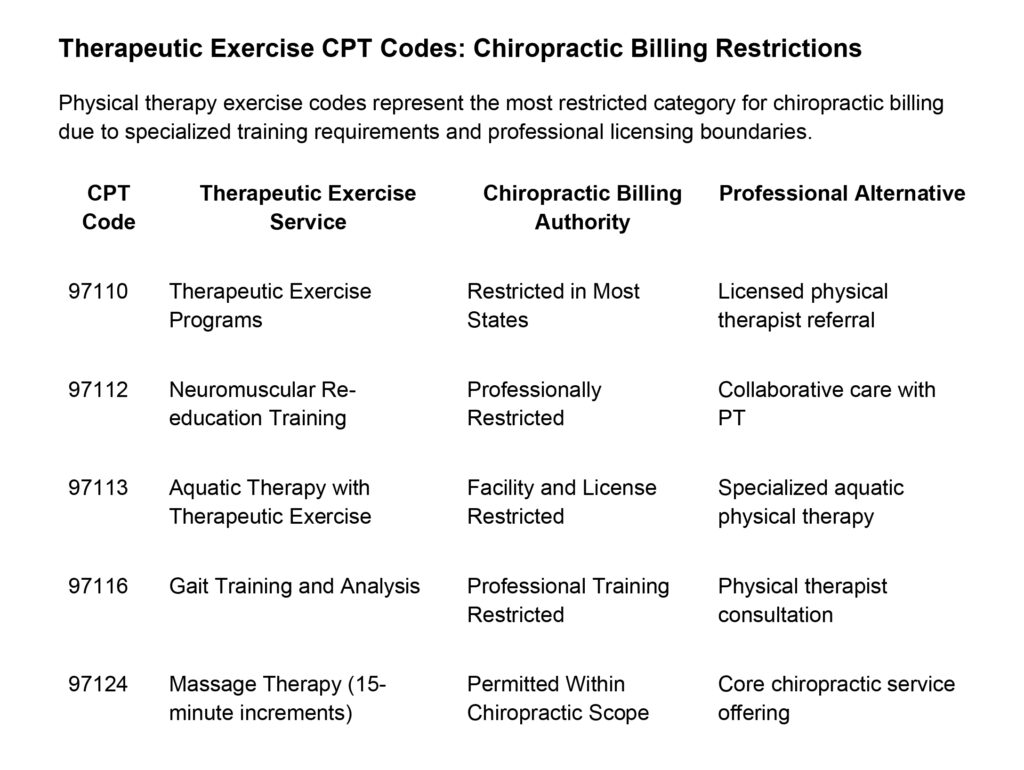
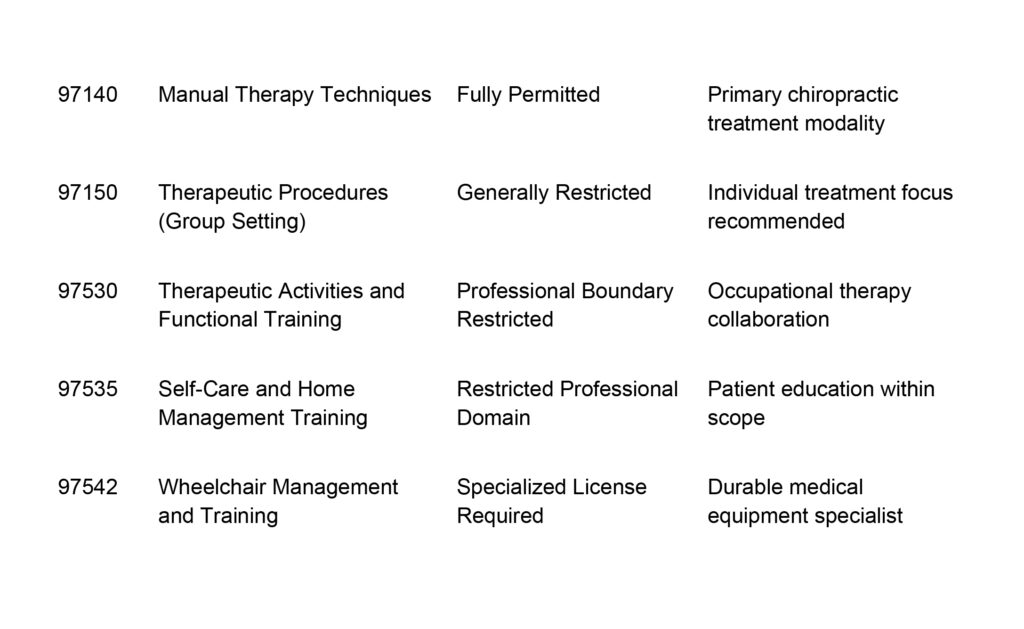
State-Specific Regulations for Chiropractic Physical Therapy Billing

Expanded Scope States Permitting Broader PT Code Usage
Several states have implemented progressive chiropractic practice acts that allow broader therapeutic service billing when practitioners meet specific educational and certification requirements.
Progressive Regulatory States:
- Arizona: Comprehensive therapeutic modality privileges with proper certification
- California: Limited physical therapy code billing with advanced certification programs
- Florida: Moderate therapeutic service overlap with continuing education requirements
- Nevada: Expanded practice rights including various therapeutic interventions
- Texas: Broad scope permissions with mandatory additional training protocols
- Washington: Progressive scope expansion with strict competency standards
Conservative Regulatory Jurisdictions for Chiropractic PT Billing
Traditional regulatory environments maintain stricter boundaries between chiropractic and physical therapy service provision.
Restrictive Practice States:
- New York: Traditional scope limitations with minimal PT code overlap
- Illinois: Conservative approach limiting modality permissions
- Pennsylvania: Strict professional boundary enforcement
- Massachusetts: Minimal therapeutic service code permissions
- Connecticut: Traditional chiropractic practice boundaries
- New Jersey: Limited expansion beyond core manipulation services
Federal Medicare Guidelines for Chiropractic Physical Therapy Billing
Medicare Coverage Limitations for Chiropractors
Medicare maintains the most restrictive position regarding chiropractic billing for physical therapy services, limiting coverage to specific manipulation codes only.
Medicare Covered Chiropractic Services:
- Exclusive coverage for CPT codes 98940, 98941, and 98942
- Subluxation documentation requirements with imaging evidence
- Annual treatment visit limitations with exception protocols
- Manual therapy code 97140 coverage under specific circumstances
- Strict medical necessity documentation standards
Medicare Non-Covered Physical Therapy Services:
- Therapeutic exercise program development and supervision
- Rehabilitation protocol design and implementation
- Maintenance care and wellness interventions
- Most therapeutic modality applications without subluxation
- Group therapy and educational program services
Medicare Documentation Requirements for Chiropractic PT Billing
Essential Documentation Components:
- Diagnostic imaging evidence supporting subluxation presence
- Detailed treatment plan with measurable functional goals
- Progress note documentation showing objective improvement
- Medical necessity justification for each billable service
- Proper modifier usage including AT (Active Treatment) designation
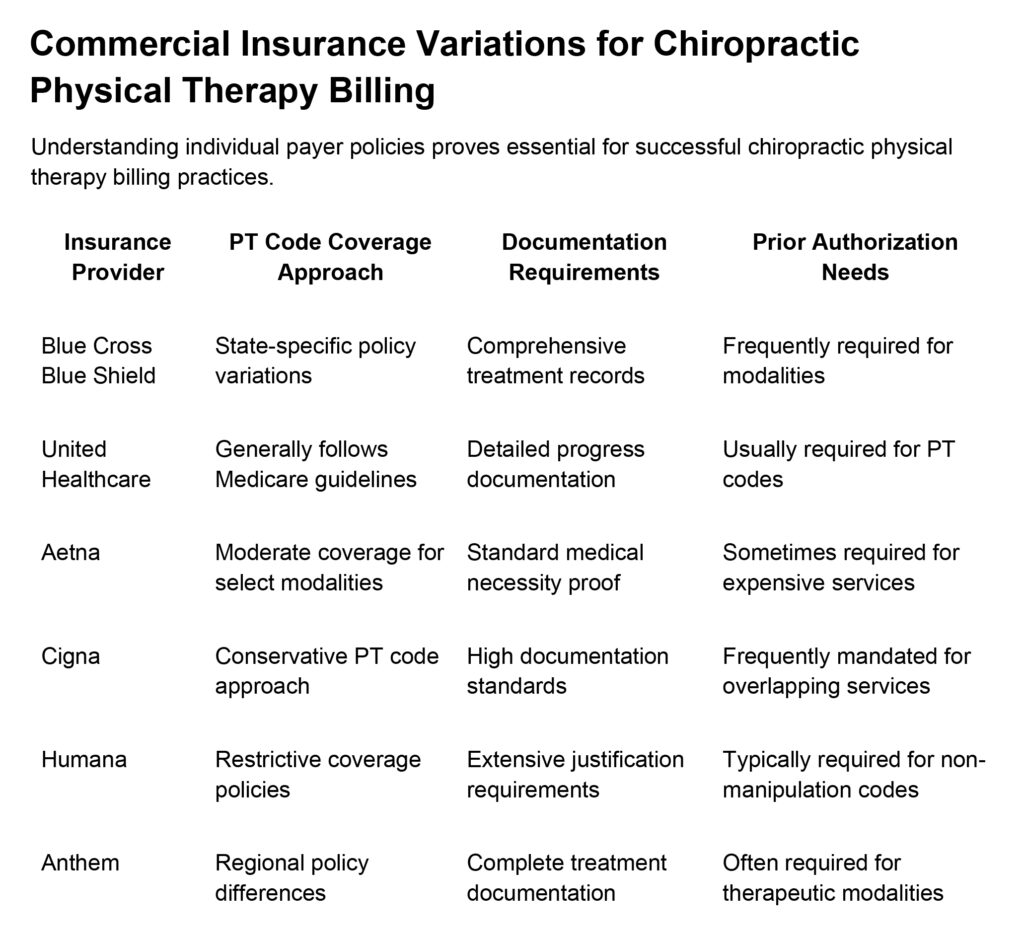
Compliance Strategies for Safe Chiropractic Physical Therapy CPT Billing
Documentation Excellence Standards for PT Code Billing
Maintaining comprehensive documentation represents the cornerstone of compliant chiropractic physical therapy billing practices.
Critical Documentation Elements:
- Clear medical necessity justification for each billable service
- Specific treatment goal establishment with measurable outcomes
- Objective progress measurement protocols and tracking systems
- Service frequency and duration rationale with clinical support
- State scope of practice compliance verification documentation
Advanced Documentation Protocols:
- Standardized assessment tool utilization for objective measurements
- Digital imaging integration supporting diagnostic and progress claims
- Treatment protocol documentation with evidence-based support
- Patient consent forms for all billable therapeutic interventions
- Equipment calibration records for modality-based treatments
Risk Mitigation Strategies for Chiropractic PT Billing Compliance
Comprehensive Compliance Framework:
- State Licensing Verification: Regular review of current scope of practice permissions
- Insurance Policy Analysis: Detailed understanding of each payer's specific requirements
- Professional Competency Documentation: Maintaining current certification and training records
- Equipment Compliance Management: Regular calibration and safety inspection protocols
- Continuing Education Tracking: Systematic documentation of professional development
- Internal Audit Implementation: Regular chart review and billing accuracy assessment
- Corrective Action Protocols: Systematic approaches to addressing compliance deficiencies
Revenue Optimization Through Legitimate Chiropractic Physical Therapy Billing
Maximizing Permitted CPT Code Reimbursement Opportunities
Strategic approaches to billing optimization focus on maximizing legitimate reimbursement while maintaining strict compliance standards.
Revenue Enhancement Strategies:
- Comprehensive utilization of clearly permitted therapeutic modalities
- Advanced training development in overlapping service competency areas
- Implementation of sophisticated documentation and tracking systems
- Professional relationship development with insurance medical directors
- Evidence-based outcome measurement protocol establishment
Service Integration Approaches:
- Collaborative care model development with licensed physical therapists
- Shared treatment protocol creation for complex patient conditions
- Cross-referral system establishment with complementary healthcare providers
- Integrated practice management for comprehensive patient care delivery
- Complementary service offering development within approved scope
Alternative Revenue Development Beyond Physical Therapy Code Billing
Cash-Based Service Expansion Opportunities:
- Comprehensive wellness program development and implementation
- Corporate ergonomic assessment and consultation services
- Advanced nutritional counseling and lifestyle modification programs
- Functional movement screening and fitness evaluation services
- Workplace injury prevention and employee health initiative programs
Technology Solutions for Compliant Chiropractic PT Code Management
Essential Billing Software Features for PT Code Compliance
Modern practice management software provides essential tools for maintaining compliance while optimizing billing efficiency.
Critical Software Capabilities:
- Real-time scope of practice verification for attempted billing codes
- Automated compliance checking against current state regulations
- Systematic CPT code update management with regulatory change alerts
- Integrated documentation template systems supporting medical necessity
- Comprehensive audit trail maintenance for regulatory review purposes
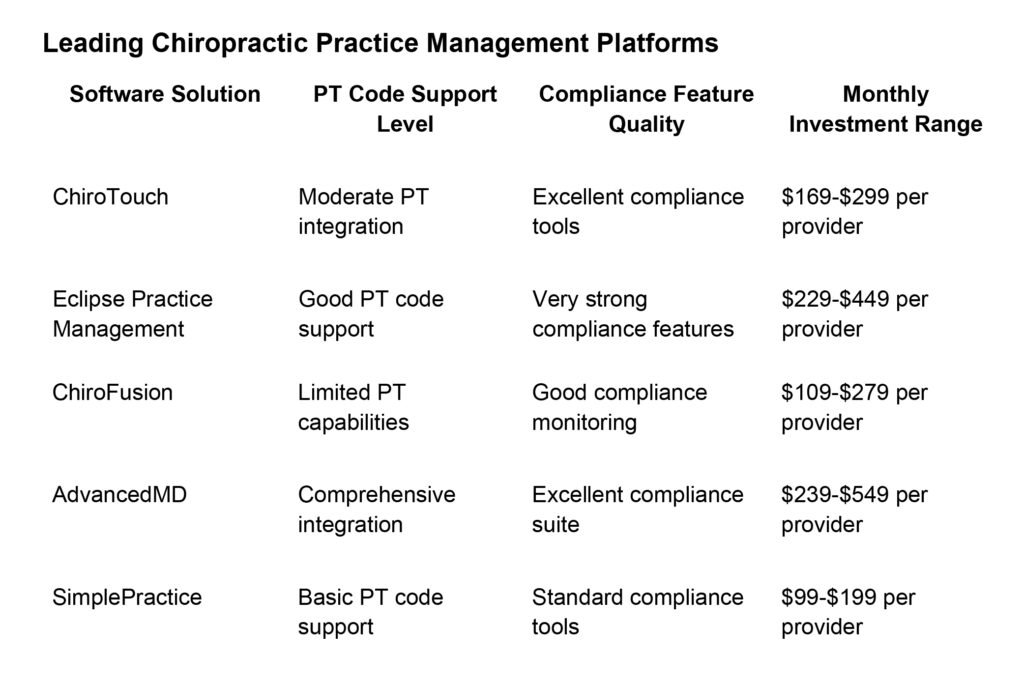
Advanced Compliance Management for Chiropractic Physical Therapy Billing
Internal Audit Protocol Development
Systematic Audit Components:
- Monthly chart review for documentation adequacy
- Quarterly billing code accuracy assessment
- Annual scope of practice compliance verification
- Regular insurance policy update review and implementation
- Systematic staff training and competency evaluation
Professional Development Requirements for PT Code Billing
Continuing Education Priorities:
- Advanced therapeutic modality training and certification
- Documentation and compliance workshop participation
- Insurance billing regulation update seminars
- Professional boundary and ethics education programs
- Technology proficiency development for practice management
Risk Management for Chiropractic Physical Therapy Billing Violations
Common Compliance Violation Patterns
Understanding frequent violation patterns helps practices develop targeted prevention strategies.
High-Risk Billing Practices:
- Billing therapeutic codes outside licensed scope of practice
- Inadequate medical necessity documentation maintenance
- Unlicensed auxiliary staff providing billable therapeutic services
- Insurance policy requirement violations and coverage limit exceedances
- Fraudulent coding practices including upcoding and unbundling
Legal Consequences of Improper Physical Therapy Code Billing
Potential Professional and Legal Penalties:
- Professional chiropractic license suspension or revocation proceedings
- Federal and state insurance fraud investigation and prosecution
- Civil liability exposure for professional negligence claims
- Criminal prosecution risks for fraudulent billing practices
- Practice closure and permanent professional exclusion possibilities
Future Trends in Chiropractic Physical Therapy Billing Regulation
Anticipated Regulatory Evolution Patterns
Emerging Regulatory Trends:
- Increased interprofessional collaboration requirement implementation
- Technology-driven service delivery model integration
- Outcome-based reimbursement system development and expansion
- Value-based care model integration for musculoskeletal conditions
- Artificial intelligence integration for compliance monitoring systems
Professional Adaptation Strategies
Strategic Development Priorities:
- Advanced collaborative care competency development
- Technology integration proficiency for modern practice management
- Evidence-based practice methodology implementation
- Quality improvement system development and management
- Professional relationship building with allied healthcare providers
Conclusion: Strategic Framework for Chiropractic Physical Therapy Billing Success
Can chiropractors bill for physical therapy services? The comprehensive answer requires careful consideration of multiple regulatory, professional, and practical factors including state-specific licensing requirements, individual insurance payer policies, proper documentation protocols, and ongoing compliance management systems.
Success in navigating this complex healthcare billing landscape demands thorough understanding of permitted CPT code utilization, meticulous record-keeping practices, continuous professional education, and proactive compliance monitoring systems.
Critical Success Implementation Factors:
- Regulatory Compliance Priority: Systematic verification of state-specific scope of practice permissions before billing any physical therapy related codes
- Documentation Excellence Standard: Comprehensive medical record maintenance supporting medical necessity for all billable therapeutic interventions
- Insurance Policy Mastery: Detailed understanding of each individual payer's specific coverage requirements and limitations
- Professional Development Commitment: Continuous pursuit of relevant certifications and collaborative healthcare relationships
- Technology Integration Strategy: Implementation of sophisticated billing software with real-time compliance verification capabilities
- Risk Management Protocol: Comprehensive compliance monitoring systems with systematic corrective action procedures
Immediate Strategic Implementation Steps:
- Conduct comprehensive scope of practice audit for current billing practices
- Review all current billing procedures for regulatory compliance accuracy
- Implement enhanced documentation protocols supporting medical necessity claims
- Establish professional relationships with licensed physical therapy practitioners
- Invest in compliant practice management technology with real-time verification
- Develop systematic ongoing compliance education and monitoring programs
Professional Growth Opportunities:
- Pursue advanced certification in permitted therapeutic modalities
- Develop collaborative care relationships with allied healthcare professionals
- Implement evidence-based practice methodologies for improved patient outcomes
- Create systematic quality improvement programs for practice enhancement
- Establish comprehensive professional development and continuing education systems
By implementing these comprehensive strategies while maintaining vigilant attention to evolving regulatory requirements, chiropractic practitioners can optimize their billing practices, maximize legitimate reimbursement opportunities, and deliver exceptional patient care within appropriate professional boundaries and regulatory compliance standards.
Transform Your Chiropractic Billing Practice with Expert Guidance
At Future Sense Consultancy, I understand the complexities healthcare practitioners face when navigating chiropractic billing regulations and physical therapy code compliance. With years of experience in medical healthcare consulting, I've helped numerous chiropractic practices optimize their billing procedures while maintaining strict regulatory compliance.
My comprehensive approach combines deep industry knowledge with practical implementation strategies. I work closely with healthcare billing specialists, experienced healthcare attorneys, and state licensing boards to ensure your practice achieves complete regulatory compliance while maximizing legitimate reimbursement opportunities for sustainable growth.
How I Can Support Your Practice:
Through Future Sense Consultancy, I offer specialized guidance that addresses your unique practice needs. My consulting services focus on practical solutions that deliver measurable results while protecting your practice from compliance risks.
Whether you're seeking to understand complex CPT code regulations, implement enhanced documentation protocols, or develop comprehensive compliance management systems, I provide the expertise and support necessary for successful practice transformation.
Ready to Optimize Your Billing Practice?
I invite you to explore how Future Sense Consultancy can support your chiropractic practice's growth and compliance objectives. My specialized knowledge in medical healthcare consulting, combined with a commitment to practical solutions, ensures your practice receives the professional guidance needed for long-term success.
This comprehensive guide provides general educational information and does not constitute specific legal, professional, or medical advice. Individual practice circumstances vary, and I recommend consulting with qualified legal counsel, certified billing specialists, and relevant professional licensing boards for jurisdiction-specific guidance tailored to your unique situation.




